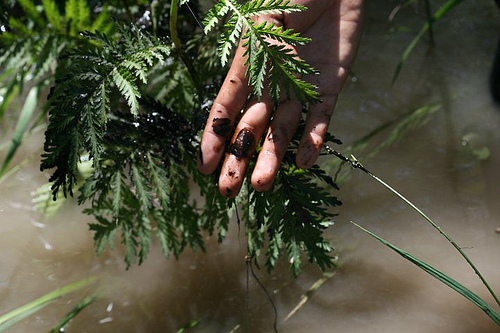
UPDATE 07/07/11 10:34AM PST: Please write President Obama to demand a ban on new oil pipelines until our communities are safe from the ones already in the ground.
It was two years ago that U.S. regulators first discovered problems with the Exxon pipeline that ruptured this past weekend and spilled 1,000 barrels (42,000 gallons) of oil into the Yellowstone River. What’s going on here?
In July 2009, federal inspectors with the Pipeline and Hazardous Materials Safety Administration (PHMSA) found evidence that an above-ground span of Exxon’s pipeline had become submerged under a creek and was piling up debris. Nearly 20 months later, in March of this year, Exxon reported that it was “evaluating control measures to keep future debris from accumulating over the pipeline.” Last weekend, in the same region cited in the inspection, the same pipeline ruptured during record flooding of the Yellowstone River.
The big question is whether these two circumstances are related. Correspondence from Exxon describes the location of the span as Pipeline Station “2211 +26 (Goldie Lane)”. That appears to be here, about 10 miles South of Laurel, MT, though without accurate pipeline maps, it’s difficult to know for certain. It’s also difficult to know the precise location of the recent leak, though an AP map shows it to be in the same area. Meanwhile, I’ve put in a call to the PHMSA requesting information on the specific location of the span mentioned in the inspection, and of the recent leak.
UPDATE 07/06/11 4:30PM PST: PHMSA says the location cited in the inspection was 10 miles south of the pipeline leak near Riverside Park in Laurel (at 2000+00).
Even if unrelated, why is the violation unresolved nearly two years after it was identified by inspectors? Correspondence available on the PHMSA website shows a “Notice of Probable Violation” sent from the Agency to Exxon on February 23, 2011. The notice pertained to an inspection more than 20 months earlier, conducted from July 27-30, 2009. Exxon’s response, dated March 24, 2011, shows that it rectified most of the violations named by PHMSA shortly after the July 2009 inspection. But on the issue of the submerged span, Exxon was still “evaluating control measures.” As flood waters rage near Laurel, the case at PHMSA is still open. In Conversations today, two PHMSA OPS Western Office representatives described a system of approvals within the agency that regularly delays correspondence with operators for months at a time.
America’s pipelines are unsafe. Exxon’s spill in Montana is just the latest in a string of accidents as long as the industry is old. And while Big Oil says that it’s learning from its mistakes, even its newest pipelines can’t seem to contain the increasingly corrosive oil mined from Canada’s tar sands. We don’t need more pipelines. Most analysts actually expect a steady decline in US demand for oil. What we do need is a system of regulations and penalties that keep our communities safe from the pipelines already in the ground.